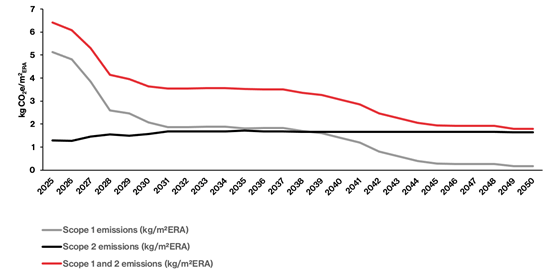Reduction path
The reduction pathway published for the first time in the 2022 financial year represents a milestone in the further reduction of greenhouse gas emissions in HIAG's existing portfolio. The reduction pathway is reviewed and updated on an annual basis to further refine the model. This ensures that new findings and changing circumstances are taken into account and communicated in a timely manner.
What does the reduction path represent?
The reduction path is a target path for reducing greenhouse gas emissions. It is based on numerous assumptions and models. It shows the Scope 1 and Scope 2 emissions under HIAG's control. It forms the basis of the greenhouse gas reduction targets and is consistently taken into account when planning upcoming maintenance and renovation work. Currently, HIAG expects that compensation measures will be necessary to achieve the net zero target by 2050. These could include the purchase of certificates. The remaining emissions are largely attributable to the district heating products purchased from contractual partners. Reducing these emissions is currently proving to be extremely challenging. HIAG assumes that district heating producers will also take measures to reduce greenhouse gas emissions. These are not taken into account in the current presentation.
Derived from the reduction path, HIAG has set itself the following goals for reducing greenhouse gas emissions in the existing portfolio (see Sustainability Goal 2022.1):
-
- The Scope 1 emissions of the existing portfolio will be reduced by 85% per m2ERA by 2035 based on the 2021 values.
- Scope 1 and 2 emissions of the existing portfolio are reduced by 65% per m2ERA
- by 2035, based on 2021 values.
- By 2050, the Scope 1 and 2 emissions of the existing portfolio are 0 kg/m2ERA net.
Reduction path of the existing portfolio including growth through completed development projects until 2050 (status: 31.12.2024):

Further information can be found in the current sustainability report.
